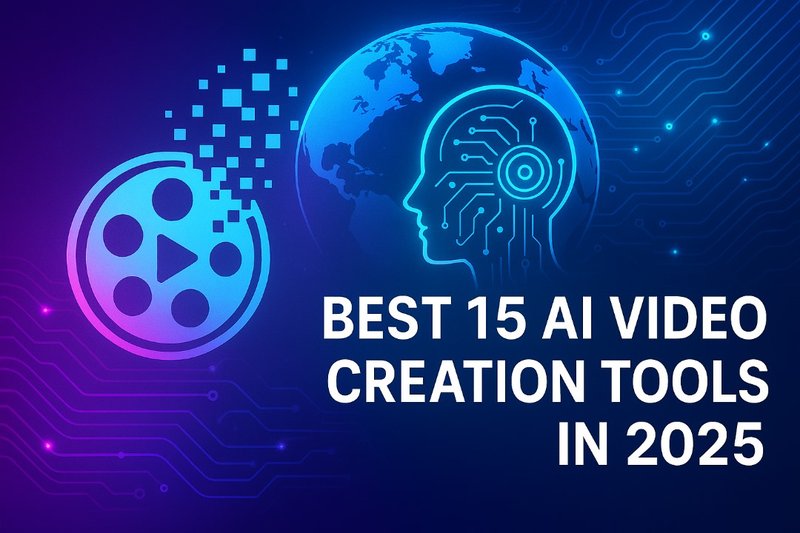Introduction: The AI Video Revolution Is Here
In 2025, AI video creation has leaped from novelty to necessity. What once required green screens, studio time, and hefty editing skills is now achievable through intuitive platforms powered by generative AI. Whether you're a content creator, marketer, educator, or filmmaker, today’s tools let anyone produce stunning visuals—from cinematic shorts and narrated tutorials to AI-hosted explainers—with just a few clicks.
This surge isn't just about convenience—it’s reshaping how we tell stories. Think: AI avatars delivering multilingual training, text prompts transforming into hyper-realistic clips, and smart editors that auto-cut, subtitle, and style videos on the fly.
In this guide, we spotlight the 15 best AI video tools of 2025, explaining what makes each unique, who it’s best for, and how it elevates your creative workflow. Click through any tool to explore its features, pricing, and ideal use cases. Ready to explore the future of video? Let’s dive in.
1. Synthesia
Imagine producing a corporate training video in 120 languages without hiring actors, renting cameras, or setting up lights. That’s exactly what Synthesia does. It’s like having a virtual cast of professional presenters ready to deliver your message anytime.
- Pros:
- Over 120 languages & accents.
- Realistic avatars (some based on real actors).
- Saves huge costs compared to traditional production.
- Cons:
- Limited customization compared to full filming.
- Avatars, while impressive, can still feel slightly robotic.
- Free/Paid: Paid (plans start around $30/month).
- Best For: Businesses creating training, marketing, or customer onboarding videos.
2. Elai.io
If Synthesia is like hiring a full TV studio, Elai feels like your own mini-production crew. It allows you to take simple text and transform it into a polished, avatar-driven video.
- Pros:
- Easy text-to-video creation.
- Avatars can be customized with your own voice clone.
- Good balance of professional and personal uses.
- Cons:
- Editing interface isn’t as advanced as traditional editors.
- Limited free trial access.
- Free/Paid: Paid (but offers demo credits).
- Best For: Educators, small business owners, and content marketers.
3. Hour One
Hour One pushes personalization further. It allows you to turn yourself — or your employees — into a virtual character, so you can automate video production while still looking and sounding like you.
- Pros:
- Create your own custom avatars.
- Great for scaling company training videos.
- Easy integration with scripts and slides.
- Cons:
- Custom avatars cost more.
- Video realism still has limitations.
- Free/Paid: Paid (enterprise-focused).
- Best For: Large organizations scaling e-learning and HR training.
✨ Mentor’s Insight:
If you’re just dipping your toes into AI video, start with Synthesia for its simplicity. But if you want to build deeper brand identity, Elai or Hour One will give you more flexibility in customization. Think of it this way: Synthesia is like renting a ready-made studio, while Hour One lets you build your own AI twin.
🌟 Section 2: AI Text-to-Video Generators
This is where the magic of turning words into movies happens. Imagine writing a blog post, dropping in a script, and within minutes — you’ve got a video ready for YouTube, TikTok, or even a business presentation. These tools bridge the gap between writers and videographers.
4. Runway
Runway is like Photoshop and After Effects had an AI-powered child. Beyond text-to-video, it gives you advanced video editing superpowers with just a few clicks. In 2025, Runway is at the front line of AI filmmaking.
- Pros:
- Cutting-edge text-to-video model (Gen-3 Alpha).
- AI-powered editing: remove backgrounds, objects, or even people.
- Great for creators experimenting with visuals.
- Cons:
- Steeper learning curve for beginners.
- Requires a strong internet connection.
- Free/Paid: Freemium (limited free tier, then subscription plans).
- Best For: Creatives, filmmakers, YouTubers who want cinematic control.
5. Pictory
Pictory is like your personal YouTube growth assistant. Paste a script, drop in a blog post, and Pictory automatically turns it into short, engaging videos complete with stock footage and subtitles.
- Pros:
- Automatic video summaries from text or long videos.
- Subtitles and captions included (great for accessibility).
- Perfect for repurposing blogs into video content.
- Cons:
- Video templates can look “stocky” if not customized.
- Works best for short-form content, not full-length films.
- Free/Paid: Paid (free trial available).
- Best For: Content marketers, coaches, and bloggers who want quick video versions of their written work.
6. InVideo
InVideo feels like Canva but for video. It combines AI text-to-video with drag-and-drop design tools, making it one of the most beginner-friendly platforms out there.
- Pros:
- Over 5,000 pre-built templates.
- AI script-to-video generator with stock footage.
- Easy social media integrations.
- Cons:
- Free plan has watermarks.
- AI narration still sounds robotic at times.
- Free/Paid: Both (Free version available, premium removes watermark).
- Best For: Social media managers, small businesses, and personal brands.
✨ Mentor’s Insight:
Think of this trio as a spectrum:
- Runway is for creatives who love experimenting.
- Pictory is for writers who want instant video versions of their words.
- InVideo is for everyday entrepreneurs and marketers who want quick, stylish videos without overthinking.
If you’re new, start with InVideo. If you’re scaling content, jump to Pictory. If you’re chasing Hollywood-style creativity, Runway is your playground.
🎬 Section 3: AI Video Editing & Enhancement
Now, let’s step into the editing room — where raw video becomes polished, professional content. In the past, video editing meant hours of dragging timelines, trimming clips, and fighting with complicated software. Today? AI does the heavy lifting, leaving you free to focus on storytelling.
Here are three tools leading the charge in 2025:
7. Descript
Think of Descript as Google Docs for video. Instead of cutting timelines, you just edit text — and the video follows. Want to remove a word you said on camera? Delete it like text. Want to cut “umms” and “ahhs”? One click.
- Pros:
- Overdub feature lets you clone your voice.
- Edit videos by editing the transcript.
- Automatic filler-word removal and captions.
- Cons:
- Voice clone requires consent + setup time.
- Cloud-based, so internet is key.
- Free/Paid: Freemium (basic free plan, advanced features in paid).
- Best For: Podcasters, educators, business trainers.
Filmora has been around for years, but the AI upgrades in 2025 make it a game-changer. It now auto-generates subtitles, color corrects, and even suggests cuts based on pacing.
- Pros:
- Beginner-friendly interface with pro-level effects.
- AI tools like auto-captioning and scene detection.
- Huge library of filters, transitions, and music.
- Cons:
- Watermark on free plan.
- Lacks the depth of Adobe for complex projects.
- Free/Paid: Both (free plan with watermark, paid unlocks full features).
- Best For: YouTubers, small businesses, hobbyist creators.
The king of video editing just got an AI crown. Adobe Premiere Pro has always been the industry standard, but in 2025, Adobe Sensei (its AI engine) takes it to another level. Think smart auto-cuts, instant scene balance, and even AI-generated background music.
- Pros:
- Professional-grade — Hollywood uses it.
- AI auto-cut and reframing save hours.
- Seamless integration with Photoshop, After Effects.
- Cons:
- Expensive subscription model.
- Steep learning curve for beginners.
- Free/Paid: Paid only (subscription).
- Best For: Professional editors, filmmakers, agencies.
✨ Mentor’s Insight:
Here’s the cheat sheet:
- If you want fast, simple, text-based editing, go with Descript.
- If you want stylish edits without stress, choose Filmora AI.
- If you want to play in the big leagues, Adobe Premiere Pro AI is your ticket.
Remember, tools don’t replace your creativity. They just remove the boring, time-consuming parts so you can focus on what matters: the message.
🤖 Section 4: AI Avatars & Virtual Presenter Tools
Imagine creating a professional training video or a brand commercial without hiring actors, setting up lights, or even recording yourself. That’s exactly what AI avatars do. They speak your script in natural tones, appear lifelike on screen, and can even translate into multiple languages instantly.
Here are the standout players in 2025:
10. Synthesia
Synthesia is the pioneer of AI avatars — and still the leader in 2025. With over 140 languages, diverse avatars, and customizable voices, it’s the go-to tool for businesses.
- Pros:
- Huge selection of avatars and languages.
- Very realistic voice and lip-sync.
- Easy to use — just paste text, choose avatar, hit render.
- Cons:
- Lacks full creative flexibility (you’re limited to their avatars).
- Subscription can be pricey for small creators.
- Free/Paid: Paid (business plans available, demo is free).
- Best For: Corporate training, explainer videos, product demos.
11. HeyGen
HeyGen is a rising star, focusing on hyper-realism. Its avatars look shockingly lifelike — almost indistinguishable from real humans. Plus, it offers handy video personalization features.
- Pros:
- Ultra-realistic avatars with strong emotional range.
- Multi-scene editor with drag-and-drop ease.
- Can create personalized avatar clones.
- Cons:
- Rendering speed can lag with longer videos.
- Still building out its avatar library.
- Free/Paid: Paid (subscription plans, trial available).
- Best For: Sales teams, personalized marketing, digital influencers.
12. Colossyan
Colossyan takes a smart approach: it doesn’t just give you avatars, it gives you role-based templates — like doctors, teachers, or office professionals. Perfect if you want your video to “feel” industry-specific.
- Pros:
- Ready-made professional avatars for specific industries.
- Script-to-video in minutes.
- Built-in collaboration tools for teams.
- Cons:
- Not as many avatars as Synthesia.
- Editing is more structured, less free-form.
- Free/Paid: Paid (various tiers, trial available).
- Best For: Training companies, HR teams, educators.
13. Elai.io
Elai.io gives you the freedom to build your own custom AI avatar. Unlike others, you can upload your footage and train a personalized digital presenter. This makes it ideal if you want you in the video without always recording yourself.
- Pros:
- Custom avatar creation from your own face.
- Multi-language support.
- Integrates with e-learning platforms.
- Cons:
- Requires setup (filming base video to create avatar).
- Less plug-and-play compared to Synthesia.
- Free/Paid: Paid (custom avatar packages cost more).
- Best For: Personal branding, online educators, course creators.
✨ Mentor’s Insight:
Here’s my advice:
- Choose Synthesia if you want tried-and-tested corporate polish.
- Go for HeyGen if realism matters most.
- Use Colossyan if your industry needs a professional look (healthcare, HR, etc.).
- Pick Elai.io if you want your own digital twin.
These tools are powerful because they remove barriers. You don’t need to hire actors or studios to look professional anymore. The question isn’t “Can I make a video?” — it’s “What message do I want to share with the world today?”
📱 Section 5: AI Social Media Video Tools
Social media is fast-paced. Trends change overnight, and attention spans are measured in seconds. To keep up, creators and brands need tools that can churn out high-impact, short-form content quickly. That’s where these AI platforms shine.
14. Pictory
Pictory is a favorite among marketers because it can turn long-form content into bite-sized clips automatically. Upload a webinar, podcast, or blog post, and Pictory will generate social-ready videos.
- Pros:
- Great for repurposing existing content.
- AI automatically picks highlights.
- Includes subtitles and branding features.
- Cons:
- Limited customization for advanced editing.
- Rendering may take time with long videos.
- Free/Paid: Paid (free trial available).
- Best For: Content marketers, podcasters, coaches.
15. InVideo
InVideo is like Canva, but for video. It comes with thousands of templates for TikTok, Instagram, YouTube, and more. Its AI assistant can even generate scripts and videos from text prompts.
- Pros:
- Massive template library.
- Easy drag-and-drop interface.
- AI script + video generator in one.
- Cons:
- Free version has watermark.
- Advanced features locked in higher tiers.
- Free/Paid: Free (with watermark), Paid plans unlock full features.
- Best For: Entrepreneurs, small businesses, social media managers.
16. Veed.io
Veed.io shines with AI subtitles, translations, and editing tools built for social platforms. It’s a go-to for creators who want accessibility baked into their videos.
- Pros:
- Automatic captions and translations.
- Screen recorder + editor in one.
- Cloud-based, no heavy downloads.
- Cons:
- Watermark in free plan.
- Some AI voiceovers sound robotic.
- Free/Paid: Free (with watermark), Paid for pro features.
- Best For: Social media influencers, educators, global brands.
17. Lumen5
Lumen5 uses AI to transform blog posts into short videos. It’s like having a video editor that reads your content and designs a mini social media ad out of it.
- Pros:
- Blog-to-video in minutes.
- Large library of stock footage & music.
- Easy brand customization.
- Cons:
- Output can look too “template-y” if not customized.
- Less suited for long videos.
- Free/Paid: Paid (basic free trial).
- Best For: Bloggers, media sites, digital agencies.
✨ Mentor’s Insight:
- If you’re sitting on hours of recorded content → Pictory will give it a second life.
- If you need speed and templates → InVideo is your weapon.
- If accessibility and captions matter → Veed.io has you covered.
- If you’re a blogger or writer → Lumen5 will repurpose your words into visuals.
Remember, in 2025 the battlefield for attention is short-form content. If you can make someone stop scrolling for 10 seconds, you’ve won. These tools help you do exactly that.
🏁 Conclusion: Choosing the Right AI Video Tool in 2025
We’ve just explored 17 of the best AI video creation tools in 2025 — from heavyweights like Runway and Synthesia, to social-first gems like Pictory and InVideo. Each one brings its own strengths, quirks, and learning curve. But the real question isn’t “Which tool is the best?” — it’s “Which tool is best for YOU?”
Here’s a way to decide:
- 🎥 If you’re a content creator who needs quick, social-ready clips → tools like Pictory, Veed.io, and InVideo will feel like magic.
- 🏢 If you’re running a business and want polished explainers or marketing videos → Synthesia and Lumen5 give you professional results fast.
- 🎨 If you’re an artist or storyteller experimenting with cutting-edge AI → Runway and DeepBrain open doors to creativity you never thought possible.
- 🌍 If you’re a global educator or coach → choose platforms with subtitles, voiceovers, and translations like Veed.io and HeyGen.
💡 Mentor’s Advice: Don’t chase every shiny tool. Instead, pick one or two that fit your workflow and master them. Remember, tools don’t make content viral — your vision, storytelling, and consistency do. AI is here to remove friction, but the spark of creativity must still come from you.
As we move deeper into 2025, video content will only grow more dominant. Audiences don’t just want to read; they want to see, hear, and feel your message. With the right AI tools in your hands, you’re no longer limited by time, budget, or technical skills. The playing field is open — and your story deserves a spotlight.
So here’s my challenge to you: Don’t just consume this list. Pick one tool today, sign up for the free trial, and create something. A short reel, a product demo, a mini explainer — whatever fits your journey. You’ll be surprised how quickly AI can turn your ideas into impact.
Because in the end, the future of content creation won’t belong to the most advanced tool.
👉 It will belong to the creators bold enough to use them.
💬 Your Turn:
Now that we’ve explored the top AI video tools of 2025, I’d love to hear from you. Which of these platforms excites you the most? Have you already tried any of them, or do you have another favorite that should be on this list?
Drop your thoughts, experiences, or even questions in the comments below 👇 — your insight could inspire another reader on their creative journey!




Comments (1)
Leave a Comment
wonderful points altogether, you simply won a new reader.
What would you suggest in regards to your put up that you just made a few days in the past?
Any positive?